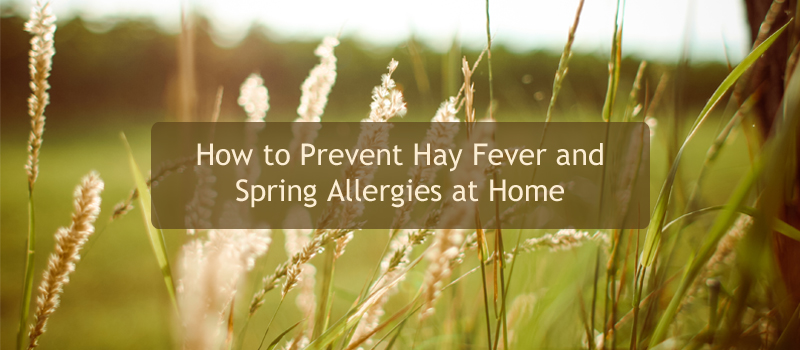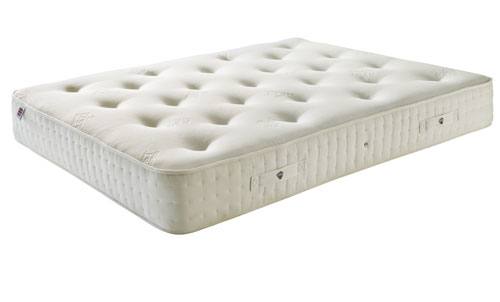Sales line (01507-611065) open : Monday - Friday, 9.30am - 5.15pm.
How to Prevent Hay Fever and Spring Allergies in Your Home
Fans of the sun, rejoice... Spring is here!
But it's not all good news. With the warmer weather and more sunlight come the dreaded spring allergies such as hay fever. If you're a sufferer of hay fever or any other spring and summer allergies, it can be a frustrating time for you.
Don't worry though, there are many steps you can take to reduce the impact it has on your daily life. And you can also prepare your home to help you avoid hay fever during spring and summer.
To show you how to combat hay fever at home, we've put together this guide.

Here's what you'll find out:
- The causes of hay fever
- Common hay fever symptoms
- Easy ways to reduce the impact of hay fever in your own home
So, what is hay fever, and why does it affect so many people? Let's find out...
What causes hay fever?
Hay fever affects about 20% of people, and if you're one of the unlucky one in in five, you'll know just what a battle it can during the spring and summer.
Hay fever is caused by pollen which acts as an allergen. There are different types of pollen which can affect different people in different ways. The most common kinds of pollen that cause hay fever are grass pollen, weed pollen and tree pollen.
The symptoms of hay fever are caused by your body fighting the pollens, which it wrongly thinks are harmful to your body.
Hay fever symptoms
There are a number of common symptoms that present themselves when you have hay fever. According to the NHS, the most likely symptoms of hay fever are:
- Regular sneezing
- Blocked nose
- Itchy or watering eyes (this is also known as allergic conjunctivitis)
- An itchy or irritated throat, mouth, nose or ears
- Coughing
Some sufferers may also find themselves with headaches, earache and tiredness.
There are plenty of over the counter medicines that can help you to overcome or control hay fever, but prevention is the best cure.
You can make some lifestyle changes in your house that will help to reduce the chances of hay fever affecting you as much as it currently does.
So if your hay fever drives you mad every spring and summer, here's how to prevent it at home...
How to prevent hay fever at home
If you regularly find yourself suffering from hay fever or spring and summer allergies, there are some steps you can take in the home to reduce its stranglehold on your life. Here are some that you can add to your routine straight away to prevent hay fever making your life a misery this spring and summer.
Hypo allergenic mattress
Some mattresses come with fibres which are hypo-allergenic, meaning they are less likely to trigger allergic reactions than standard mattresses.

If you do suffer form allergies, try replacing your mattress with a hypo-allergenic one. You can also furnish your bed with hypo-allergenic sheets and pillows to offer further protection.
Don't cut the grass
If your garden needs tending to or the grass needs cutting, it might be best if you get someone else to do it, particularly as 95% of hay fever sufferers are affected by grass pollen. Once you start mowing the lawn, more pollen is released which can trigger your allergy.
Ask a friend or family member to do it, or even consider paying a professional gardener so that you don't have to deal with the consequences.
Take shoes off at the door
While you're out and about during the spring and summer, your shoes are highly likely to pick up pollen and allergens that can trigger your hay fever. Take your shoes off as soon as you walk through the door, and encourage others who live with you to do the same. This will reduce the chances of allergens being walked through the house on people's shoes.
Keep windows closed
Pollen naturally moves around in the air, so open windows make it easy for the pollen to drift into your home. If you suffer from hay fever, keep your windows closed as much as possible during the day to reduce the amount of pollen that gets into your home.
It might be tempting to sleep with the window open during summer, but try using a fan or air conditioning unit to cool you down instead.
Dry clothes indoors
When it comes to the laundry, you always pray for a warm and dry day that allows you to hang the clothes out to dry. But pollen can attach to your fresh laundry, causing an allergic reaction or flare up of hay fever when you bring it in and wear it. Instead, it might be best to stick to drying your clothes indoors, either using an airer or a tumble dryer.
Dust regularly
Pollen is not just airborne outside. Once it's in the home, it can also easily drift around with dust. To prevent this, regularly clean your surfaces with a damp cloth, which will help to stop the pollen travelling in the air inside your house.
Vacuum the floors
If you have carpets, these can be another place where pollen gathers in the house and therefore trigger allergies. Vacuum your carpets regularly to ensure that pollen is kept to a minimum.
Keep your sofa clean
As well as carpets and furnishings, pollen can also gather on your sofas and suites – particularly if they are fabric ones.
Cleaning your suite regularly will keep pollen levels in your home to a minimum, as well as keeping it fresh. You can find out more about how to clean your suite in our sofa cleaning and care guide.
Shower before bed
If you've been outside at all during the day, pollen can collect in your hair, which then transfers itself to your pillow. This can cause your hay fever to flare up as you try to sleep, which is not a good recipe for a good night's rest.
Before you go to bed or enter the bedroom, take a shower and wash your hair. It's also a good idea to change into fresh clothes that won't bring pollen into your bedroom.
Keep an eye on the pollen count
It's always good to know in advance when you are most at risk of being affected by pollen. Keep tabs on the weather or check the internet for updates on the pollen count in your area. If it's high (between 50 and 150), remember to keep your windows and doors closed at home to prevent pollen drifting in.
Don't let your hay fever control your life
Unfortunately, many people find their spring and summer is ruined by hay fever. But it doesn't have to be that way.
Follow our tips above and your home will be much easier to live in if you do suffer from hay fever.
Do you have any other tips for preventing hay fever at home? Let us know by leaving a comment below.



















